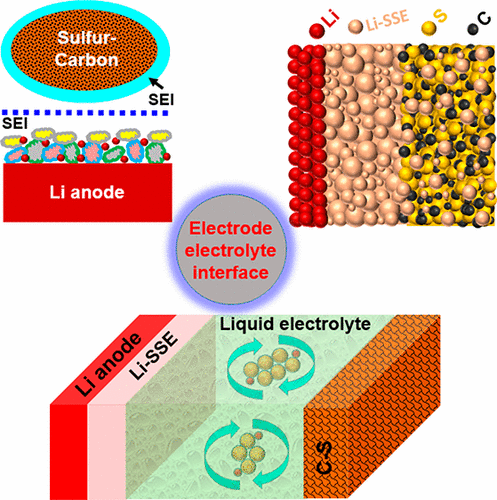当前位置:
X-MOL 学术
›
Acc. Chem. Res.
›
论文详情
Our official English website, www.x-mol.net, welcomes your
feedback! (Note: you will need to create a separate account there.)
Electrode–Electrolyte Interfaces in Lithium–Sulfur Batteries with Liquid or Inorganic Solid Electrolytes
Accounts of Chemical Research ( IF 16.4 ) Pub Date : 2017-11-07 00:00:00 , DOI: 10.1021/acs.accounts.7b00460
Xingwen Yu 1 , Arumugam Manthiram 1
Accounts of Chemical Research ( IF 16.4 ) Pub Date : 2017-11-07 00:00:00 , DOI: 10.1021/acs.accounts.7b00460
Xingwen Yu 1 , Arumugam Manthiram 1
Affiliation

|
Electrode–electrolyte interfacial properties play a vital role in the cycling performance of lithium–sulfur (Li–S) batteries. The issues at an electrode–electrolyte interface include electrochemical and chemical reactions occurring at the interface, formation mechanism of interfacial layers, compositional/structural characteristics of the interfacial layers, ionic transport across the interface, and thermodynamic and kinetic behaviors at the interface. Understanding the above critical issues is paramount for the development of strategies to enhance the overall performance of Li–S batteries. Liquid electrolytes commonly used in Li–S batteries bear resemblance to those employed in traditional lithium-ion batteries, which are generally composed of a lithium salt dissolved in a solvent matrix. However, due to a series of unique features associated with sulfur or polysulfides, ether-based solvents are generally employed in Li–S batteries rather than simply adopting the carbonate-type solvents that are generally used in the traditional Li+-ion batteries. In addition, the electrolytes of Li–S batteries usually comprise an important additive, LiNO3. The unique electrolyte components of Li–S batteries do not allow us to directly take the interfacial theories of the traditional Li+-ion batteries and apply them to Li–S batteries. On the other hand, during charging/discharging a Li–S battery, the dissolved polysulfide species migrate through the battery separator and react with the Li anode, which magnifies the complexity of the interfacial problems of Li–S batteries. However, current Li–S battery development paths have primarily been energized by advances in sulfur cathodes. Insight into the electrode–electrolyte interfacial behaviors has relatively been overshadowed.
中文翻译:

液体或无机固体电解质在锂硫电池中的电极-电解质界面
电极-电解质界面特性在锂-硫(Li-S)电池的循环性能中起着至关重要的作用。电极-电解质界面的问题包括界面处发生的电化学和化学反应,界面层的形成机理,界面层的组成/结构特征,离子在界面上的传输以及界面处的热力学和动力学行为。了解上述关键问题对于制定增强Li-S电池整体性能的策略至关重要。Li-S电池中通常使用的液体电解质与传统锂离子电池中使用的电解质相似,后者通常由溶解在溶剂基质中的锂盐组成。然而,+离子电池。另外,Li–S电池的电解质通常包含重要的添加剂LiNO 3。Li-S电池独特的电解质成分使我们无法直接采用传统Li +离子电池的界面理论并将其应用于Li-S电池。另一方面,在对Li-S电池充电/放电期间,溶解的多硫化物类物质会通过电池隔板迁移并与Li阳极发生反应,这加剧了Li-S电池界面问题的复杂性。但是,当前的Li-S电池开发途径主要是由硫阴极的发展所激发。对电极-电解质界面行为的了解相对被遮盖了。
更新日期:2017-11-07
中文翻译:

液体或无机固体电解质在锂硫电池中的电极-电解质界面
电极-电解质界面特性在锂-硫(Li-S)电池的循环性能中起着至关重要的作用。电极-电解质界面的问题包括界面处发生的电化学和化学反应,界面层的形成机理,界面层的组成/结构特征,离子在界面上的传输以及界面处的热力学和动力学行为。了解上述关键问题对于制定增强Li-S电池整体性能的策略至关重要。Li-S电池中通常使用的液体电解质与传统锂离子电池中使用的电解质相似,后者通常由溶解在溶剂基质中的锂盐组成。然而,+离子电池。另外,Li–S电池的电解质通常包含重要的添加剂LiNO 3。Li-S电池独特的电解质成分使我们无法直接采用传统Li +离子电池的界面理论并将其应用于Li-S电池。另一方面,在对Li-S电池充电/放电期间,溶解的多硫化物类物质会通过电池隔板迁移并与Li阳极发生反应,这加剧了Li-S电池界面问题的复杂性。但是,当前的Li-S电池开发途径主要是由硫阴极的发展所激发。对电极-电解质界面行为的了解相对被遮盖了。































 京公网安备 11010802027423号
京公网安备 11010802027423号